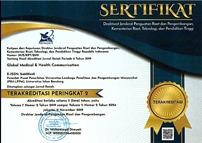Associated Tinnitus Risk Factors in Patients with Type 2 Diabetes Mellitus
Abstract
Keywords
Full Text:
PDFReferences
International Diabetes Federation. IDF Diabetes Atlas. 10th Edition. Brussels: International Diabetes Federation; 2021.
Taneja N. Tinnitus, hearing impairment and diabetes: a mini-review. Otolaryngol Open J. 2017;Spec 5:S6–9.
Mousavi SHG, Sajadinejad B, Khorsandi S, Farhadi A. Diabetes mellitus and tinnitus: an epidemiology study. Maedica (Bucur). 2021;16(4):580–4.
Baharudin AS, Kiat NC, Isahak N, Xin TW, Zhaki FNA, Rasyid NA, et al. Prevalence of tinnitus in type II diabetes mellitus with or without hypertension patients in Universiti Kebangsaan Malaysia Medical Centre. Int Med J. 2017;24(5):398–401.
Panahi R, Jalali MM, Joukar F, Maroufizadeh S, Naghipour M, Mansour-Ghanaei F. Prevalence of tinnitus and its associated factors in the PERSIAN Guilan Cohort Study. Iran J Otorhinolaryngol. 2023;35(126):29–38.
Biswas R, Lugo A, Akeroyd MA, Schlee W, Gallus S, Hall DA. Tinnitus prevalence in Europe: a multi-country cross-sectional population study. Lancet Reg Health Eur. 2022;12:100250.
Jarach CM, Lugo A, Scala M, van den Brandt PA, Cederroth CR, Odone A, et al. Global prevalence and incidence of tinnitus: a systematic review and meta-analysis. JAMA Neurol. 2022;79(9):888–900.
Oosterloo BC, Croll PH, Baatenburg de Jong RJ, Ikram MK, Goedegebure A. Prevalence of tinnitus in an aging population and its relation to age and hearing loss. Otolaryngol Head Neck Surg. 2021;164(4):859–68.
Dhulipalla S, Makkena A, Gowthami B, Sravani B. A cross sectional study of prevalence of hearing impairment and tinnitus in type 2 diabetes mellitus patients. EJMCM. 2023;10(4):976–82.
Musleh A, Alshehri S, Qobty A. Hyperlipidemia and its relation with tinnitus: cross-sectional approach. Niger J Clin Pract. 2022;25(7):1046–9.
Lee HJ, Lee DC, Kim CO. The association between serum lipid levels and tinnitus prevalence and severity in korean elderly: a nationwide population-based cross-sectional study. Yonsei Med J. 2024;65(3):156–62.
Ramatsoma H, Patrick SM. Hypertension associated with hearing loss and tinnitus among hypertensive adults at a tertiary hospital in South Africa. Front Neurol. 2022;13:857600.
Huang PH, Xirasagar S, Chen JH, Cheng YF, Kuo NW, Lin HC. Absence of association of tinnitus with pre-existing hypertension: a population-based study. Ann Otol Rhinol Laryngol. 2023;132(7):756–62.
Swain SK. Impact of tinnitus on quality of life: a review. Int J Adv Med. 2021;8(7):1006–10.
Henry JA, Griest S, Zaugg TL, Thielman E, Kaelin C, Galvez G, et al. Tinnitus and hearing survey: a screening tool to differentiate bothersome tinnitus from hearing difficulties. Am J Audiol. 2015;24(1):66–77.
Bashiruddin JE, Alviandi W, Reinaldo A, Safitri ED, Pitoyo Y, Ranakusuma RW. Validity and reliability of the Indonesian version of tinnitus handycap inventory. Med J Indones. 2015;24(1):36–42.
National Cholesterol Education Program (NCEP) Expert Panel on Detection, Evaluation, and Treatment of High Blood Cholesterol in Adults (Adult Treatment Panel III). Third Report of the National Cholesterol Education Program (NCEP) Expert Panel on Detection, Evaluation, and Treatment of High Blood Cholesterol in Adults (Adult Treatment Panel III) final report. Circulation. 2002;106(25):3143–421.
American Diabetes Association Professional Practice Committee. 2. Classification and diagnosis of diabetes: standards of medical care in diabetes—2022. Diabetes Care. 2021;45(Suppl 1):S17–38.
Reisinger L, Schmidt F, Benz K, Vignali L, Roesch S, Kronbichler M, et al. Ageing as risk factor for tinnitus and its complex interplay with hearing loss—evidence from online and NHANES data. BMC Med. 2023;21(1):283.
Cole JH, Marioni RE, Harris SE, Deary IJ. Brain age and other bodily 'ages': implications for neuropsychiatry. Mol Psychiatry. 2019;24(2):266–81.
Langguth B, Landgrebe M, Schlee W, Schecklmann M, Vielsmeier V, Steffens T, et al. Different patterns of hearing loss among tinnitus patients: a latent class analysis of a large sample. Front Neurol. 2017;8:46.
Gupta S, Eavey RD, Wang M, Curhan SG, Curhan GC. Type 2 diabetes and the risk of incident hearing loss. Diabetologia. 2019;62(2):281–5.
Avcı D. Increased serum lipid levels in patients with subjective tinnitus. Iran J Otorhinolaryngol. 2021;33(114):31–6.
Bachor E, Selig YK, Jahnke K, Rettinger G, Karmody CS. Vascular variations of the inner ear. Acta Otolaryngol. 2001;121(1):35–41.
de Moraes Marchiori LL, de Almeida Rego Filho E, Matsuo T. Hypertension as a factor associated with hearing loss. Braz J Otorhinolaryngol. 2006;72(4):533–40.
Shargorodsky J, Curhan GC, Farwell WR. Prevalence and characteristics of tinnitus among US adults. Am J Med. 2010;123(8):711–8.
Kim HJ, Lee HJ, An SY, Sim S, Park B, Kim SW, et al. Analysis of the prevalence and associated risk factors of tinnitus in adults. PLoS One. 2015;10(5):e0127578.
Spankovich C, Yerraguntla K. Evaluation and management of patients with diabetes and hearing loss. Sem Hear. 2019;40(4):308–14.
Yenny Y, Herwana E, Wratsangka R. Skor risiko diabetes mellitus berkorelasi dengan kadar gula darah puasa: skrining diabetes mellitus tipe-2 pada masyarakat. Jurnal AKAL. 2022;3(2):193–207.
Kumar P, Singh NK, Apeksha K, Ghosh V, Kumar RR, Kumar Muthaiah B. Auditory and vestibular functioning in individuals with type-2 diabetes mellitus: a systematic review. Int Arch Otorhinolaryngol. 2022;26(2):e281–8.
pISSN 2301-9123 | eISSN 2460-5441
Visitor since 19 October 2016:
Global Medical and Health Communication is licensed under a Creative Commons Attribution-NonCommercial-ShareAlike 4.0 International License.






























.png)
_(1).png)
_(1).jpg)
